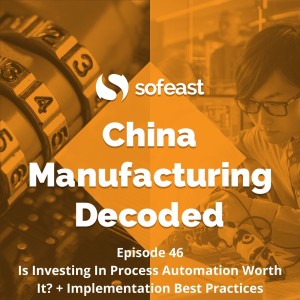

Is Investing In Process Automation In The Factory Worth It? (+ Implementation Best Practices)
Adrian asks Renaud the questions: "Is Investing In Process Automation In The Factory Worth It?" and "What are the best practices to follow to smoothly transition into more automation?"
In China especially, there's a trend to replace staff with equipment, and part of this automation drive comes from the government itself who is steering the manufacturing sector towards higher-tech products.
As staff costs rise, the temptation to use equipment and robots due to the seemingly lower cumulative cost over time is understandable, but is process automation truly worth it, and If we do want to implement automation into the factory, what are the best practices to follow to make it a smooth transition? That's what we get into here...
Show Notes
00:00 - Introducing the episode
02:35 - Summarising process automation in the factory - essentially it's the use of equipment and software to replace human labor. This sounds great and can be, but this episode aims to dispel a lot of the fantasy surrounding automation.
05:07 - Is rushing into automation common amongst Chinese manufacturers? - yes, the government and owners are focused on going higher-tech more quickly, but they're walking a tightrope between increasing equipment use and putting too many staff out of work. The usual attitude is that to go up in the value chain processes need to be automated, which is somewhat true, but it's the implementation of automation where things can go wrong if it's rushed into and the pros and cons aren't fully investigated and considered.
07:54 - The benefits & drawbacks of automation in the factory - going through a list, starting with the benefits:
Benefits
- (08:07) Lower costs of equipment in comparison to employing numerous operators over time (labor cost/social insurance/etc)
- (10:27) Equipment reduces defects over operators (human error) and removes the need for an operator that focuses on rework
- (11:30) Reducing management overheads and maybe even dispensing with requiring an HR manager to manage multiple staff
Drawbacks
- (12:09) The cost of interest on capital expenditure - quite high in China, around 8-10%
- (12:35) The costs of specialized staff required to run and maintain the equipment
- (14:02) Cost of getting the machinery to work properly (setup/time/needing operators to work during this)
- (15:44) Maintenance - a large driver of costs (parts, downtime, training skilled staff, etc) and really important for highly automated factories (listen to more about preventive maintenance here)
- (20:36) Automation can reduce a factory's flexibility - manual labor allows a factory to be flexible and provide high mix/low volume work, but automation reduces this flexibility and leans more toward low mix/high volume work. Your higher MOQs may remove the ability to take smaller orders which can return more profit.
- (22:08) Lead times could be reduced by equipment, but often it's not the case - in theory, automation means more parts can be made more quickly, but often Chinese manufacturers make a lot of inventory and don't take advantage of it and it doesn't improve lead times.
22:57 - Many manufacturers don't take many of the disadvantages into account - this can mean that the cost of equipment VS operators over, say, 10 years works out at more! Pivoting is easier with a human workforce.
24:31 - What are automation best practices followed by the 'best manufacturers?' - Toyota's approach is to automate or remove DDD (dull, dangerous, and dirty) operations without focusing on ROI, as staff safety is more important.
25:59 - The wrong way to implement automation - rushing into heavy automation will cause trouble mainly due to your staff struggling to be skilled and familiar enough to handle the maintenance effectively. This can cause downtime, scrap, and reduced equipment lifetimes so is a serious problem.
Before implementing full automation, you should try...
26:32 - Re-engineering human operations - Before implementing automation, the best companies have process engineers check the operations humans are doing and assess how to make those more efficient. So that's re-engineering human operations to reduce 'waste' and increase the seconds per minute that they are physically working on transforming each piece, for example, through improving the layout of and logistics around the production line and providing enhanced training to the operators and their group leader. This can reduce staff numbers and improve efficiency and quality.
28:54 - Semi-automating some of the operations - now you have improved the efficiency of operators you can look into implementing some automation to assist operators to become even more productive, for example, a machine that delivers a part into place for them to transform and then ejects it, reducing their time spent not transforming parts. Again, this should reduce staff numbers and improve efficiency and quality.
31:46 - Some of the problems factories face when rushing into highly technical automation too soon - if a machine goes down it can hold up the whole production until the machine is cleared, for example. But the worst case is that a machine gets broken and can't be used until replacement parts can be obtained.
33:35 - If your supplier informs you that they're implementing automation, how to handle that? - make sure that they're conducting a pilot run that is isolated from the rest of production and they are not recklessly rushing into it. This is a good thing, though, as it shows that they're investing in the company and looking to the future.
34:35 - Renaud's blueprint to implementing automation efficiently - assess whether tools even necessary or is reducing waste in manual operations, for example, a worthy goal? Re-engineer processes with lean manufacturing tools.
The trend is that over time automation will be increasingly required by most manufacturers helpful, so starting with semi-automation to make the operator's routines more efficient starts to train them and the maintenance staff to work with automation and equipment (maybe with one pilot line to start with) now makes sense.
As you go along, more and more processes can be automated step-by-step, and this will be accompanied by a reduction in staff required in turn.
37:24 - Automation is NOT just robots - Michel Baudin wrote in this blog post that PLCs (programmable logic controllers) outsell industrial robots by millions to one each year. These units control the equipment and processes and the reality of most manufacturing operations is that robot arms, for example, are not actually what is used to automate processes at all.
39:40 - Wrapping up
Related content...
- Chinese Manufacturer Selection: Beware of Excessive Automation
- The Right Way To Approach Production Automation
- Will You Save Money With Process Automation In Your Factory?
- Connect with us on LinkedIn
- Send us a tweet @sofeast
- Prefer Facebook? Check us out on FB
- Contact us via Sofeast's contact page
- Subscribe to our YouTube channel
There are more episodes to come, so remember to subscribe! You can do so in your favorite podcast apps here:
- Apple Podcasts
- Spotify
- Stitcher
- Google Podcasts
- TuneIn
- Deezer
- iHeartRADIO
Get in touch with us
-
- Connect with us on LinkedIn
- Contact us via Sofeast's contact page
- Subscribe to our YouTube channel
- Prefer Facebook? Check us out on FB
More Episodes
All Episodes>>Create Your Podcast In Minutes
- Full-featured podcast site
- Unlimited storage and bandwidth
- Comprehensive podcast stats
- Distribute to Apple Podcasts, Spotify, and more
- Make money with your podcast












